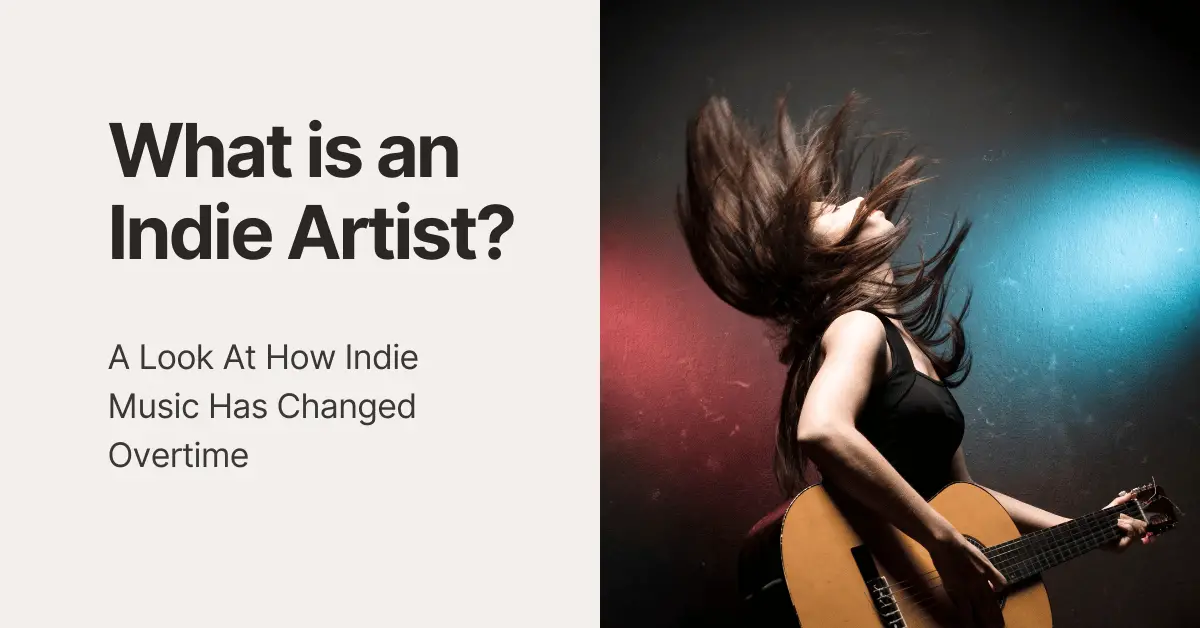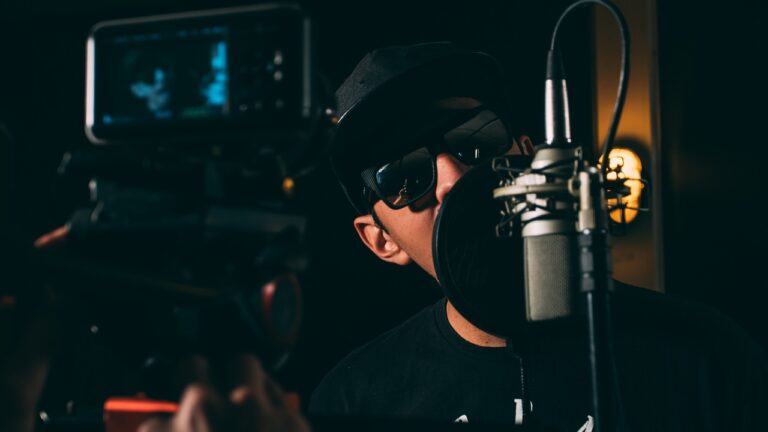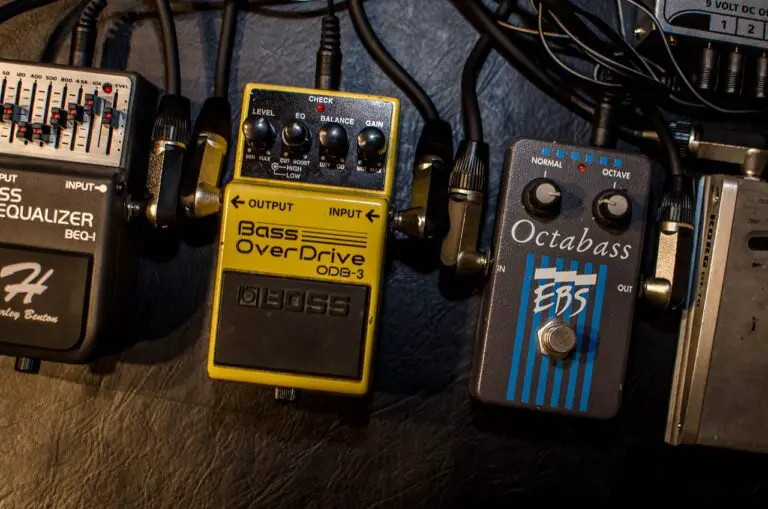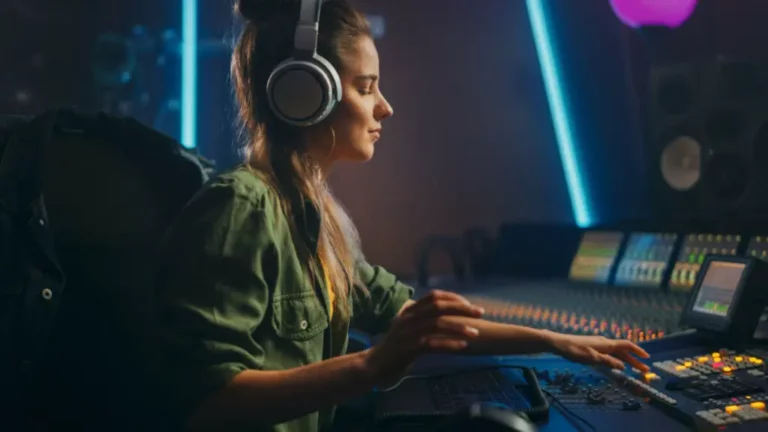What is an Indie Artist? The Two Definitions
When you hear “indie,” an image might jump into your head. You might see some sad, bearded man with an acoustic guitar singing about a long-lost love. Indie is the music connected to the “you just haven’t heard of it” crowd. But, like other stereotypes, this isn’t what indie actually is. So, what is an indie artist?
An indie artist is short for an “independent artist.” What makes them independent is their separation from major record companies. Indie artists will perform record-label duties themselves or sign with an independent label.
Below, you’ll learn more about what it takes to become an independent artist. You’ll also learn more about the history of indie and some famous artists who are part of the indie scene.
The Debate – What Makes An Artist Truly Indie?
Indie, or independent, music, brings small artists to mind. When people think of indie, they think about someone with a microphone and an acoustic guitar. While many indie artists fit this label, just as many don’t.
All bands who are just starting fall into the indie category. They don’t have the support or the connections to join a major record label. This leaves them to do it themselves until they succeed enough to gain recognition.
Even when joining a record label, it will likely be independent of the major companies. After all, major commercial record labels (like Sony or Universal) hold considerable control and power. They want to direct this control and power to the world’s most prominent artists, not someone working toward their first ten or even 100 thousand fans.
But some prefer talking about indie music as a sound.
What Makes A Band Sound Indie?
When you think of an indie sound, you might think of the popular song “When Soul Meets Body” by Death Cab for Cutie. It’s soulful, sad, and everything you might expect from indie music.
But Death Cab for Cutie isn’t technically indie, as they’ve signed with Atlantic Records. But, in 2004, when The John Byrd EP came out, they were signed with Barsuk Records, one of those independent labels.
So, the band was indie at one point, but they are no longer indie. Still, you’ll see people classify their genre as “indie rock” despite no longer being independent.
Is Indie a Genre of Music?
In modern times, indie has taken on a life beyond its classic definitions. That definition connects it with an alternative and (sometimes) folk style of music.
So, in modern terms, an indie musician doesn’t have to be an independent music artist. You could have an indie artist signed with one of those major labels we discussed earlier.
This leads us to one of those common assumptions about indie: commercial success doesn’t mean that a band automatically stops being indie. Popular music is not the opposite of indie.
Modest Mouse is another example of an independent band joining a major label and maintaining the indie label. Float On still holds some of that old semi-folksy charm but was successful and popular.
So, despite some debate, modern indie music fits more than one label. So, a big record company could be involved with an indie artist.
What is Indie Rock As A Music Genre?
Independent rock (short for “indie rock”) is a subgenre of rock music characterized by its low-budget approach to creating music. It’s a similar approach to “indie pop,” which is pop made without the big budgets behind some major artists.
Indie rock was initially a term for the grittier side (alternative rock). But, the umbrella grew to include various genres outside the mainstream.
Bands like Modest Mouse, The Bravery, and The Killers are three such examples. But, many of these hit the mainstream with songs like “Mr. Brightside” and “Dashboard.”
Indie rock was also a genre that crossed into other areas. The Strokes, more of a punk rock band, fell under the genre due to their maverick-like approach to music-making.
These days, the indie rock (and indie pop) genre includes a mix of bands with and without the budget for creating large music productions. So, with the genre muddied, what can you rely on?
As unsatisfying as it might be, the answer is: it’s up to you. Our definitions of words and labels change as we move. In 10 years, the “indie” genre will shift into a new phase, likely including a list of artists outside this scope. So, enjoy the music, and try not to worry about labels.
The Power of Indie Musicians in 2023 – Why You Might Not Need A Record Label
Twenty years ago, MySpace was founded by Tom Anderson and Chris DeWolfe. MySpace was a clear call to online advertisers: you don’t need the big bucks to get your name out there. Social media is a landscape of potential to grow your music.
MySpace started a foundation of uploading your content, sharing it with your friends, and having those friends share with others. It meant you could reach an audience without relying on a record label.
Facebook, which eventually overtook MySpace, became even more powerful. They capitalized on the popularity of social media with a simpler interface. These days, it’s hard to find someone who doesn’t have a Facebook account. Finding your audience is easier than ever, and social media is built to connect people with what they want.
This means people will find you if you are an indie artist who consistently makes good music. You must keep people interested and encourage them to share your music with new people.
How Do Indie Artists Distribute Their Music?
Indie artists distribute their music like major labels do: through distribution networks. However, they don’t have access to the same distributors, meaning they must rely on those catering to small-time sellers.
CDBaby, for example, is the largest music distribution company for indie artists. Because they don’t discriminate based on the size of the artist, literally anyone can start. You can also use their tools to promote your music.
Other music distribution companies, like Landr music, compete with CDBaby in similar venues. These days, it’s good to “level the playing field” to let these independent musicians get a chance.
Major labels still have a distinct advantage: money and power. They partner with recognizable artists and use their deep pockets to spread new releases everywhere. Despite independent distributors leveling the playing field a bit, indie artists can’t get the same exposure (unless they have a lot of buried gold in the backyard).
Pros and Cons of Being an Indie Artist
Not everything is sunshine and roses with your music career as an indie artist. Sometimes, you have to deal with some bad situations.
Here’s a quick list of pros and cons for indie artists:
Pros
- Because you don’t answer to a major label, nobody tells you what to do
- You take a bigger chunk of royalty checks related to music releases
- Because you’ve put in the work, your fan base is more likely to be loyal
- You control what happens to your music (your music won’t be on anything you don’t want it on)
- You don’t have to fall to the whims of the mainstream music industry
Cons
- You have to put a lot more work into spreading your music
- If you choose to sign with a small label, indie music labels don’t have the same spread as major labels
- Music piracy is a challenging issue to overcome if you don’t have the money to defend it
- Your royalties might be lower because you lack clout
- All of the music connections you make will be hard fought
Ultimately, work is the biggest hurdle you must overcome as an indie artist. Instead of relying on record labels to expedite your opportunity for success, you need to be the one to do all of it.
The same could be said for any business. This bad assumption in business (music or otherwise) is that “if you build it, they will come.” But, as content producers will tell you, throwing your music into an ocean of other people trying to do the same thing might not get the results y
Four Famous Members of the Indie Genre
Indie falls into both genres and “independents.” Below are four famous members of the indie music genres who aren’t independent musicians:
1. Death Cab for Cutie
Death Cab for Cutie is the definitive version of what people consider indie. Ben Gibbard, the frontman, is likely the inspiration for many of the independent stereotypes with his soulful, sad approach to music making.
Death Cab stretched what “indie” truly met in 2004 when they signed to a major record: Atlantic Records. The band continues its stint with Atlantic, maintaining solid popularity.
2. The Killers
The Killers is another huge artist stretching our concept of indie. The band was formed in 2001 by Brandon Flowers and Dave Keuning.
Like Death Cab, The Killers initially signed with a small-time label. But, with the insane popularity of “Mr. Brightside,” they signed with a more prominent label (Island Def Jam).
These days, The Killers continue to kill it (sorry) with songs like “Battleborn.”
3. Modest Mouse
Modest Mouse is one of the older bands on this list, formed in 1993 by Isaac Brock, Jeremiah Green, and Eric Judy. Like many of the bands on this list, there were also concerns when they transferred to a major label: Epic.
But, with popular songs like “Float On” and “Dashboard,” Modest Mouse managed to break out and become truly magnificent.
Unfortunately, one of its founding members, Jeremiah Green, passed away in 2022. We wish the best for Modest Mouse, and the families affected.
4. Bob Dylan
For classic music lovers, Bob Dylan’s 60-year career contains themes of rebellion. The antiwar movement inspires his music during the Vietnam War. Songs like “Blowin’ in the Wind” and “The Times They Are a-Changin'” are the voice of a generation fighting against war.
Like other independent artists on this list (except for Chance), Bob Dylan is not “indie” because he signed with Columbia, a major label dating that still persists.
How Do Independent Musicians Get Popular Without Record Labels? 3 Real-World Examples
As we’ve said earlier, independent and popular artists can be the same. The term “indie” isn’t another way to say unpopular.
But from a traditional perspective, getting popular without the support of a major label seems impossible. After all, you can’t do it all by yourself.
Below, you’ll find real-world examples of artists making it big without connecting to a major label.
1. Chance the Rapper
From an indie purist’s perspective, you can’t get more accurate than Chance the Rapper. He has never signed with a major label and has even turned down Kanye West in merging with one.
So, how did he grow without the backing of a major corporation? From a musical perspective, he wrote music that resonated with people on a deeper level.
One of his most popular examples, “Pusha Man,” came with his second mixtape: Acid Rap. It shares a sad story about losing his friend in a moment of violence. He draws attention to the dangers of the inner city and how those in power do nothing about it. It’s a powerful, real sentiment that people connect with.
2. Macklemore
Macklemore is another independent breakout artist with massive popularity. His best-known work, “Thrift Shop,” reached number one on the Billboard Hot 100 in 2013.
Before becoming popular, he held the stage name “Professor Macklemore,” relating his debut album, The Language of My World, in 2005. He also worked with Ryan Lewis, which worked with him on “Thrift Shop.”
Consistently playing across many small clubs made Macklemore popular. It also helps that he’s incredibly talented, writing all his own music and going behind what you might connect with a typical “rapper.”
3. Frank Ocean
Frank Ocean took his name from mashing together Frank Sinatra and a film he starred in, “Oceans 11.” For a time, he was part of a well-known record label: Def Jam Recordings.
But, after feeling neglected by the major record label (saying he “never walked through the building“), he created a mixtape with no input. That self-relead tape was Nostalgia, Ultra, released online (for free) to critical acclaim.
While he persisted with Def Jam, releasing free music is a good lesson. Also, it helps that the release was independent (it had nothing to do with the label). If you want to stand out in the music industry, worry more about spreading your music than getting paid.
Also, don’t just stick to your local streaming platform. Release stuff your fans can collect (or some digital releases).
What Can We Learn From These Indie Success Stories?
You’ve also probably noticed a theme: a lot of hip-hop music is indie. This is a solid departure from the assumption that sad dudes with acoustic guitars make up the indie music scene. So, you don’t have to fit an alternative rock stereotype to be indie.
Rap artists are great people to emulate when pounding the pavement. They are relentless, talented, and keep trying until something works out.
These people aren’t talented overnight. They work for their craft. So keep practicing, keep playing shows, and always work to improve.
They also didn’t do it by themselves. They did it by collaborating with other artists. Each has multiple featured artists across their albums, a real-world example of the value of making connections.
Wrap-Up – What Makes An Indie Artist Truly Indie?
Like any label, indie can mean several things (depending on who you ask). The music industry will tell you many things, but ultimately, it returns to humble roots.
What makes modern indie music “indie” is starting with very little. At some point in any band’s life, they will have experienced what it means to be indie.
Many of these bands fit the stereotypes you connect with indie music. But, some (like Chance) take the other side of the definition (the side that doesn’t sign with record labels).
If you decide to start a band tomorrow, you will be indie. Whether you maintain that label will depend on what you want, how the music industry changes, and the perception of what people come to understand.








